It's feel like I'm stuck, my friends. Can somebody explain me pick equations from "Pearls of Functional Algorithm Design", chapter 11 ("Not the maximum segment sum").
Here is the problem (a little bit simplified) Let us have some states with given transitions:
data State = E | S | M | N
deriving (Show, Eq)
step E False = E
step E True = S
step S False = M
step S True = S
step M False = M
step M True = N
step N False = N
step N True = N
Now, let's define pick:
pick q = map snd . filter ((== q) . fst) . map (\a -> (foldl step E a, a))
The author claims that the following seven equations hold:
pick E xs = [[]]
pick S [ ] = [ ]
pick S (xs ++ [x]) = map (++[x ]) (pick S xs ++ pick E xs)
pick M [ ] = [ ]
pick M (xs ++ [x ]) = pick M xs ++ pick S xs
pick N [ ] = [ ]
pick N (xs ++ [x]) = pick N xs ++ map (++[x]) (pick N xs ++ pick M xs)
Can somebody explain me in simple words, why these equations are true, how can we prove an obvious proof? I feel like I almost understand S-equations, but altogether this remains elusive.
